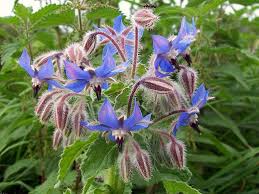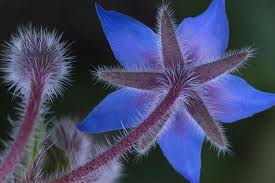Full sun to dappled shade
Height: 2-3 feet/60-90 cm
Soil: Average to rich soil, well-draining; allowed to dry in between waterings
Borage is an old herb, known at least since Roman times.
It is said that borage gladdens the heart, and surely the purple flowers are cheery. But even the small, young leaves are slightly prickly, and the plant may seem rather coarse to a new gardener.
Still, it can add color and interest to any garden, and it has value in the kitchen as well. For the avid herb gardener, it’s a must.
Description
Borage is also known as star flower. The flowers are, indeed, a star shape with 5 pointed purple or pink petals (flowers are often pink upon opening, and then turn purplish blue). The star shape is enhanced by five green sepals that appear at each spot where two petals meet, around the center of the flower.
There is a cultivar of borage that produces white flowers as well.
Borage leaves do contain a small amount of silica which may irritate the skin of sensitive individuals, so handle with care, whether they are fresh or dried. The leaves, stems, and sepals of borage are covered with fine, silvery or white hairs that give the plant a soft sheen. The hairs may add to the plants appearance, but some people find the bristle of hairs discourages them from putting borage to greater use in the kitchen.
Cultivation
 Borage is one of the easiest plants to grow from seed. If it is allowed to bloom & set seed, it will readily self-seed providing a new generation of borage each year (which may or may not be desirable).
Borage is one of the easiest plants to grow from seed. If it is allowed to bloom & set seed, it will readily self-seed providing a new generation of borage each year (which may or may not be desirable).
Borage is a hardy annual which means that the seeds can be sown outside in the early spring, or even in the fall and overwintered in the soil ready to come up at the first signs of spring.
Borage seeds need complete darkness to germinate. A full layer of soil should do the trick. Borage is not likely to be successfully transplanted because of its long taproot. Always plant borage in the pot or plot it is intended to grow. When other plants are sown indoors, usually 4-8 weeks before the last frost, borage can be sown outside, where it will germinate within a few days or weeks.
Seeds
Borage seeds are 5-6 millimeters long, and about half as wide, making them larger than many other herb seeds, and easier to sow. They look like little seed pods, with grooves running along the side and a cap on top.
Because borage self-seeds, it can provide many new plants each spring. However, it is not likely to be invasive since it spreads above-ground (from seeds coming from the flower heads) rather than underground (as in the case of the mints, which spread through stolons).
Unwanted borage plants are fairly easy to remove and keep in control. Just be sure to weed them out before mid-summer to prevent them from flowering and setting more seeds.
Borage seeds have a fairly long shelf life – the official number given is 3 years. However, I have seeds that are almost 5 years old, & earlier this spring I got a nearly 100% germination rate.
Soil
Borage originates in the Mediterranean, and prefers an average to rich, well-draining soil. Since over-watering is often (ironically) a greater problem than under-watering, be sure that you allow the soil around the borage to dry in between waterings. Working some compost into the soil before planting borage will ensure plenty of nutrients for your borage plants, but don’t add an excessive amount.
Since borage readily re-seeds itself, adding a thin layer of compost each fall as a mulch is likely to not only provide nutrients for the next year’s borage plants, but it also adds a little protection to the seeds that have fallen from the flowers and will over-winter in the ground.
In the Garden
Borage is a medium-height plant and will do well in the middle of a flower border. Its stems are hollow and succulent, but if they get tall, the lower area can be somewhat bare and unsightly, with sucker branches here and there displaying only a flower or two.
The greatest glory of borage is at the very top of the main stems, where the droops of borage flower buds are congregated en masse. Planted in the middle of a flower border, with some shorter plants in front, it is a well-balanced display.
Pinching the terminal buds may be effective in reducing the height of the plant and increasing compactness.
Companion Planting
Borage is very useful in the garden. It attracts bees, which increases pollination of nearby plants. Borage may also enhance the growth of tomatoes (by confusing and repelling tomato hornworm); brassicas (by repelling and confusing cabbage worms); and strawberries may do better when grown near borage.
Other plants that seem to improve when grown near borage: cucumbers, beans (including climbing and bush beans), grapes, zucchini/squash, and peas. It is not known to be antagonistic toward any plants.
Borage is also useful as a mulch and in a compost pile. Its leaves and stems contain calcium and potassium which may account for another reason why tomatoes do well near borage. Blossom end rot, which affects tomatoes, is caused by lack of calcium. Potassium helps plants to bloom and set fruit, which may increase production in tomatoes and strawberries. Whatever reasons for planting borage, it is likely to do a lot of good for your garden.
In the Kitchen
The smaller, younger leaves are best in fresh salads since they are not quite as bristly as the older leaves. If you still find them too disagreeable to eat fresh, you may find they are more useful when they’re chopped up and added to soups or sautéed dishes.
Remember that borage tastes like cucumber, so wherever cucumber flavor is needed, borage is likely to be able to act as a substitute. Borage can also be used only for the flavoring during the cooking, and then removed from the dish before serving.
Culinary Uses
1. Borage and Cream Cheese Spread: Finely chop young borage leaves and onion; mix with cream cheese. Add skim milk to spreading consistency. Use on light sandwiches.
2. Candied Borage Flowers: Remove the sepals from the flower. Paint the flowers with egg whites and dip in a very fine sugar. Unpasteurized egg whites carry the risk of food poisoning, so as an alternative, use 1 Tbsp of gum arabic and 1 Tbsp of water. Use to garnish deserts. (A good beginner’s guide: Edible Flowers: Deserts & Drinks by C. Barash)
3. Freezing borage flowers in ice cubes is a fun addition to summer drinks.
4. A borage vinegar can be used in making salad dressings and it’s probably the only satisfactory way to store borage. Freezing & drying produce unsatisfactory results.
5. A refreshing tea is made by pouring a cup of boiling water over ¼ cup of bruised borage leaves; steep for 5 minutes; strain & serve. Young borage leaves also go well in lemonade.
Herbal Use & Notes
Borage may help heal insect bites and inflamed or infected cuts. Either use finely chopped borage leaves, or make a tea by pouring 4 cups of boiling water over a large amount of leaves; steep, strain, and pour into a spray bottle. Spray on skin for cooling and healing. The silica may cause irritation to the skin in some individuals, so use it cautiously.
Borage may affect lactation in pregnant and nursing women, so it’s best if it’s not used by a breastfeeding mother.
Cautions: Some herbalists warn that borage can be toxic to the liver. Borage has been eaten by thousands of people for centuries and is likely to be consumed in complete safety, but it is always good to be moderate in your consumption. In large amounts, borage may have a diuretic effect.
Interest: I’ve noticed that when my borage plants are less-healthy, the flowers tend to stay pink. If you have borage plants with many pink flowers, add compost, compost tea, or other organic feed.
I found these great tips in Best Gardening. WikiHow has steps to plant borage.


0